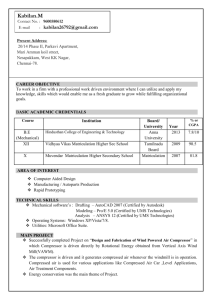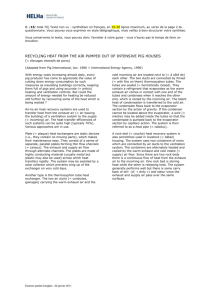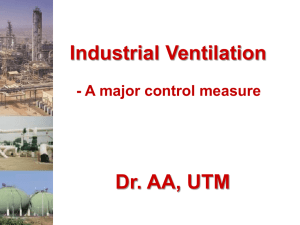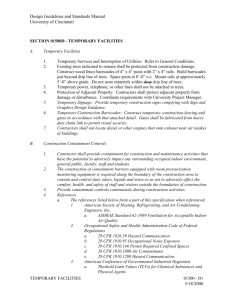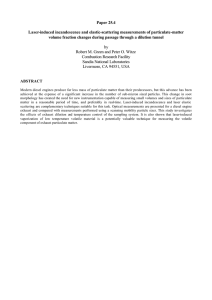TWH-V-24
advertisement
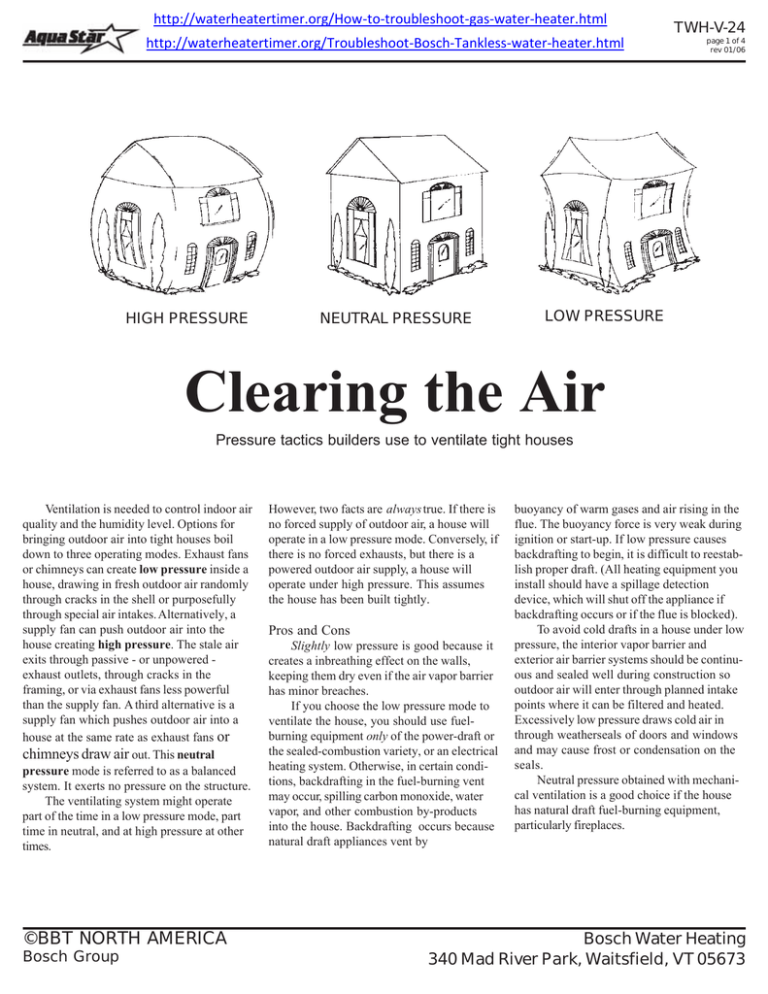
http://waterheatertimer.org/How-to-troubleshoot-gas-water-heater.html http://waterheatertimer.org/Troubleshoot-Bosch-Tankless-water-heater.html HIGH PRESSURE NEUTRAL PRESSURE TWH-V-24 page 1 of 4 rev 01/06 LOW PRESSURE Clearing the Air Pressure tactics builders use to ventilate tight houses Ventilation is needed to control indoor air quality and the humidity level. Options for bringing outdoor air into tight houses boil down to three operating modes. Exhaust fans or chimneys can create low pressure inside a house, drawing in fresh outdoor air randomly through cracks in the shell or purposefully through special air intakes. Alternatively, a supply fan can push outdoor air into the house creating high pressure. The stale air exits through passive - or unpowered exhaust outlets, through cracks in the framing, or via exhaust fans less powerful than the supply fan. A third alternative is a supply fan which pushes outdoor air into a house at the same rate as exhaust fans or chimneys draw air out. This neutral pressure mode is referred to as a balanced system. It exerts no pressure on the structure. The ventilating system might operate part of the time in a low pressure mode, part time in neutral, and at high pressure at other times. ©BBT NORTH AMERICA Bosch Group However, two facts are always true. If there is no forced supply of outdoor air, a house will operate in a low pressure mode. Conversely, if there is no forced exhausts, but there is a powered outdoor air supply, a house will operate under high pressure. This assumes the house has been built tightly. Pros and Cons Slightly low pressure is good because it creates a inbreathing effect on the walls, keeping them dry even if the air vapor barrier has minor breaches. If you choose the low pressure mode to ventilate the house, you should use fuelburning equipment only of the power-draft or the sealed-combustion variety, or an electrical heating system. Otherwise, in certain conditions, backdrafting in the fuel-burning vent may occur, spilling carbon monoxide, water vapor, and other combustion by-products into the house. Backdrafting occurs because natural draft appliances vent by buoyancy of warm gases and air rising in the flue. The buoyancy force is very weak during ignition or start-up. If low pressure causes backdrafting to begin, it is difficult to reestablish proper draft. (All heating equipment you install should have a spillage detection device, which will shut off the appliance if backdrafting occurs or if the flue is blocked). To avoid cold drafts in a house under low pressure, the interior vapor barrier and exterior air barrier systems should be continuous and sealed well during construction so outdoor air will enter through planned intake points where it can be filtered and heated. Excessively low pressure draws cold air in through weatherseals of doors and windows and may cause frost or condensation on the seals. Neutral pressure obtained with mechanical ventilation is a good choice if the house has natural draft fuel-burning equipment, particularly fireplaces. Bosch Water Heating 340 Mad River Park, Waitsfield, VT 05673 TWH-V-24 page 2 of 4 rev 01/06 A neutral pressure mechanical ventilation system for a tight house uses several fans and ducts as in this example: 1) a powered intake for outdoor air; 2) a passive intake for outdoor air; 3) a fan for the intake; 4) the cold air plenum for the furnace; 5) the furnace blower; 60 the warm air plenum for the furnace; 7) the bathroom exhaust register; 8) a kitchen exhaust register; 9) an exhaust fan; and 10) an exhaust damper. The power intake and exhaust are wired to operate together Neutral pressure is recommended in situations where high volumes of fresh air are needed. The exhaust fans sweep areas clean of moisture or pollution better in houses operating in the neutral mode. Some heating engineers used to favor high pressure to keep the cold air from infiltrating, but today high pressure is not recommended in cold climates. When houses were leaky, it was thought better to have warm air going out than cold air coming in. This strategy was not much of a problem for 2x4 wall construction and dry air houses. Now walls are thicker and fully insulated to save energy. People prefer to have comfortable indoor humidity in the winter. Pushing humidified air through walls or into attics in well insulated houses is not wise because it will cause condensation in the outer (colder) layers of construction and result in frozen doors and windows. Guidelines You will find it difficult to control indoor air pressure levels precisely - especially if you do not want to spend a lot of money on the ventilation equipment and installation. ©BBT NORTH AMERICA Bosch Group Exhaust only systems designed for low pressure operation - 50 to 250 cfm fans in the bathrooms, kitchen and laundry room - are commonplace and usually workable in homes of average tightness. Purchase the best quiet fans you can find (2.5 sones or lower) because homeowners will not use noisy ones. (Remember, you should have power draft or sealed combustion fuel burning heating equipment in houses operating under low pressure). When all the exhaust fans operate simultaneously (perhaps together with a 2000 cfm clothes dryer), the indoor air pressure may be so low that the weaker exhaust fans hardly move air at all. The worst result will be a brief period of stagnation or excessive humidity in some rooms, usually the bathroom. In quality built homes with tight air and vapor barriers, an exhaust only ventilation system may not work well because supply air cannot enter easily. Excessively low pressure may choke flow in the exhaust fans. So quality homes generally should have a regulated outdoor air supply. A fairly simple system is a motorized intake damper interlocked to the largest exhaust fan. More sophisticated systems have air intakes with controllable dampers. The widest open setting is wired to the largest exhaust fan. An outdoor air intake connected to the suction (return) of a furnace air circulating fan works will when it is designed properly. But a large undampered fresh air feed to the return side of a warm air heating system should not be installed because it may create high pressure in the house when the furnace operates. For example, an air intake duct the same size as the common flue (usually 6 inches) connected to the suction side of the air handler of a warm air furnace is too large unless it has a damper that automatically opens only when the exhaust fans are operating. Since building codes may prohibit dampers in outdoor air intakes for combustion, a second smaller undampered fresh air intake (3 to 4 inches) connected to the suction of the furnace may be needed to satisfy codes. In such an arrangement, moderate amounts of outdoor air will be drawn into the return duct when the furnace is operating, roughly balanced by the exhaust air exiting via the furnace flue. If additional outdoor air is needed to satisfy the building Bosch Water Heating 340 Mad River Park, Waitsfield, VT 05673 TWH-V-24 page 3 of 4 rev 01/06 code, outdoor air may be ducted to the floor level near the heating appliance. Certain high volume exhaust units are powerful enough to create very low air pressure. Downflow kitchen range vents or commercial type exhaust hoods are capable of 600 to 1000 cfm. In most homes, the high volume exhausts will require correspondingly large outdoor intakes. Another solution is to be sure the occupant opens a window when the range vent or exhaust hood is used. Of course, you cannot guarantee what the homeowners will do after they take possession of the house. Open windows are likely to cause discomfort during cold weather. In some tight European houses, supply air inlets with air filters are placed near radiators. In homes with forced air central heating, outdoor air can be ducted into the forced air system if the proper guidelines are followed regarding pressure modes. The air supply duct should have a motorized damper, which is normally closed. The damper should open and the furnace fan should operate at the right speed to balance the outdoor air supply with exhaust flow. A separate thermostat, wired in parallel with the main thermostat in the house, can be installed in the return ducting of the forced air system at the point of outdoor air intake: The furnace burners can start immediately when cold fresh air is drawn in. Two-stage gas firing would work well - the low stage fires when the duct thermostat call for heat; the stage fires when the main thermostat calls for heat. The outdoor air supply thermostat can be set at 50-60°F to avoid starting the furnace during mild weather when the house might overheat. Supply air can be warmed up with heat reclaimed from the exhaust air before it is vented, such as with an air to air heat exchanger otherwise known as a heat recovery ventilator (HRV). Air source heat pumps can also preheat supply air with reclaimed exhaust air heat. Most HRV's and ventilating heat pumps are conveniently packaged appliances that maintain neutral or slightly low air pressure in the house. These systems are very suitable for a basic level of whole house ventilation systems that run continuously. ©BBT NORTH AMERICA Bosch Group Even with a balanced ventilation system, the house may still need outdoor air supply to keep pressure neutral when the range exhaust or clothes dryer is operating. (In cold climates, increasing the flow of intake air through the heat recovery ventilator would only freeze the unit). A supply air intake with a motorized damper electrically tied to the range exhaust is recommended in tight houses to feed outdoor air into a warm air heating system. The intake is matched to the size of the exhaust unit it serves. The furnace manufacturer should be consulted regarding the ability of the equipment to deal with cold air, particularly in high volume situations. Q: What is the proper size for an exhaust system? A: A bathroom fan should provide at least 100 to 150 cfm. A kitchen exhaust fan should provide at least 200 cfm. Or a central fan can be sized to provide the total exhaust airflow needed. The central system can be run at partial speed when less ventilation is needed. A larger fan motor running at a slower speed is also generally quieter and lasts longer. And, of course, the extra capacity is handy when household activities produce moisture or odors. Q: Why is a range hood exhaust often installed in houses that have a central HRV system? A: Range hood exhaust systems are designed to handle grease from cooking. Many HRV systems have difficulty with grease. The high volume hood exhaust can be operated for short periods as needed. duct installed between wall studs works well with a transition to round duct under the floor. Blowers can be fitted into round duct using sheetmetal end caps cut to fit the blower inlet and discharge openings. Q: Why not vent the exhaust fans through the roof? A: In cold weather they draw air continuously like a chimney. Moisture from the air condenses inside the ductwork and may freeze or drip. The chimney effect wastes warm air at times when ventilation is not needed. Snow may block the exhaust outlets on the roof. Loosely fitting ventilator units in the ceiling can release moisture into attics, wet insulation and cause significant heat loss. Q: Where should the outdoor air intakes be placed? A: An intake is most conveniently located in the rim joist. Intakes should be at least 10 feet from the nearest exhaust vent and away from outdoor odors or car exhausts. They should be at least 1 foot above the ground and have a weather hood and insect screen. Q: What are the advantages of a central exhaust system? A: A central blower requires only one fan and one exhaust vent to the outdoors. Backdraft dampers are not needed in exhaust branch ducts since all branches are under suction. One 6 inch round vent to the outdoors is usually mounted in the floor joists in the basement. Controls from upstairs rooms can Q: Where should exhaust registers and ductwork be placed? A: In the kitchen and in each bathroom. A register may also be desirable in the laundry area. They should be placed about 7 feet above the floor. Kitchen exhaust registers can be placed above cabinets or above the range. Downflow in rectangular Bosch Water Heating 340 Mad River Park, Waitsfield, VT 05673 TWH-V-24 page 4 of 4 rev 01/06 A low pressure mechanical ventilation system for a tight house could have separate exhaust fans or use just one central blower resulting in fewer penetrations through the building envelope A duct to the return air of the furnace provides part of the makeup air supply. Another intake drops outdoor air to the floor level. Simple flanges and hose for a setup identical to this one are sold in a kit called Equaliz-Air from Xavier, Inc. P.O. Box 9371, Livonia, Mich. 48154 be wired with low voltage doorbell wire, using a 24 volt relay at the blower. Flow regulators or timer activated exhaust registers are available to control the exhaust from each room. A two-speed or variable speed control works well for a central blower system. Speed can usually be reduced in the second year of a new house because moisture and pollutants will diminish over time. A central blower system can even be as energy efficient as individual blowers because some families run all the separate fans simultaneously during morning and evening activities. heat to be used for space heating and cooling as well as domestic hot water. Payoffs depend on the amount of ventilation needed, the heat recovery efficiency of the equipment, and the local price of fuel. Roger Alan Peterson is a housing and energy consultant based in Minneapolis. Q: How can noise and vibration be minimized? A: A permanent split capacitor motor is quieter than other blowers and draws less wattage. Vibration can be minimized by mounting the blower with rubber cushions and cushion connectors to the duct runs. All ducting materials for range exhausts must be approved for fire and grease resistance by local code authorities. Q: Is the investment in heat recovery equipment worthwhile? A: Heat recovery should be regarded as an option that can be added to ventilator system. If a house is heated with a high priced source, the extra expenditure for a heat recovery ventilator is usually a good investment in a tight house. Heat recovered from the exhaust air can be transferred to the incoming fresh air or can be used to heat domestic water in heat pump systems. Some equipment allows the ©BBT NORTH AMERICA Bosch Group Bosch Water Heating 340 Mad River Park, Waitsfield, VT 05673
